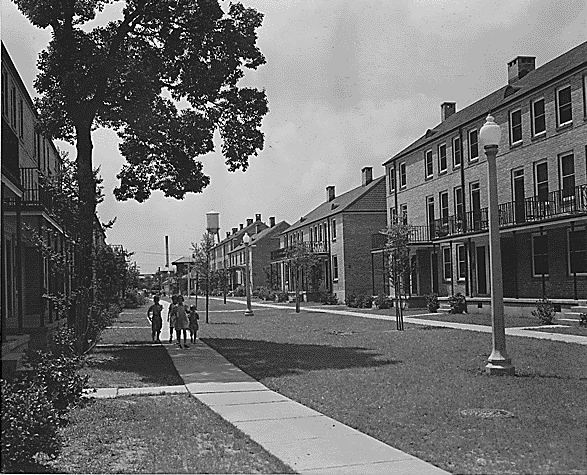- St. Thomas Development
Geobox Neighborhood
name = St. Thomas Development
native_name =
other_name = River Garden
other_name1 =
category = New Orleans Neighborhood

image_caption = St. Thomas Projects, early 1940s
flag_size =
symbol =
symbol_size =
etymology_type =
etymology =
nickname =
motto =
country = United States
state = Louisiana
region_type = City
region = New Orleans
district_type = Planning District
district = District 2, Central City/Garden District
area_imperial = 0.27
area_land_imperial = 0.23
area_water_imperial = 0.04
area_water_percentage = auto
area_percentage_round = 2
area_round = 1
location =
lat_d = 29
lat_m = 55
lat_s = 34
lat_NS = N
long_d = 90
long_m = 04
long_s = 21
long_EW = W
elevation_imperial = 7
elevation_round = 1
population_as_of = 2000
population = 2957
population_density_imperial = auto
established_type =
established =
mayor =
timezone = CST
utc_offset = -6
timezone_DST = CDT
utc_offset_DST = -5
postal_code =
postal_code_type = ZIP Codes
area_code = 504
area_code_type =
code2_type =
code2 =
free_type =
free =
free1_type =
free1 =
map_size =
map_caption =
map_locator =
map_locator_x =
map_locator_y =
website =St. Thomas Development is a neighborhood of the city of New Orleans and a former
Housing Projects of New Orleans . A subdistrict of the Central City/Garden District Area, its boundaries as defined by the City Planning Commission are: Constance, St. Mary, Magazine and Felicity Streets to the north, theMississippi River to the south and 1st, St. Thomas, and Chippewa Streets and Jackson Avenue to the west.Geography
St. Thomas Development is located at coor dms|29|55|34|N|90|04|21|W|city GR|1 and has an elevation of convert|7|ft|1GR|3. According to the
United States Census Bureau , the district has a total area of convert|0.27|sqmi|1. convert|0.23|sqmi|1 of which is land and convert|0.04|sqmi|1 (14.81%) of which is water.Adjacent Neighborhoods
* Lower Garden District (north)
*Mississippi River (south)
* Irish Channel (west)Boundaries
The City Planning Commission defines the boundaries of St. Thomas Development as these streets: Constance Street, St. Mary Street, Magazine Street, Felicity Street, the
Mississippi River , 1st Street, St. Thomas Street, Chippewa Street and Jackson Avenue. [cite web|url=http://gnocdc.org/orleans/2/59/index.html|title=St. Thomas Development Neighborhood|author=Greater New Orleans Community Data Center|accessdate=2008-06-21]Demographics
As of the
census GR|2 of 2000, there were 2,957 people, 834 households, and 608 families residing in the neighborhood. Thepopulation density was 12,857 /mi² (4,928 /km²).History
The St. Thomas Housing Project was one of the housing projects of New Orleans. It was bordered by St. Thomas Street to the south, a service alley between Constance and Laurel Streets to the north, Felicity Street to the east and Josephine Street to the west. It was built in the 1941, and originally consisted of 120 buildings covering almost ten full city blocks. Under segregated housing laws in place until the 1960s it was occupied by white tenants.
St. Thomas became one of the city's most dangerous developments by the late 1980s. In 1996, the Housing Authority of New Orleans received a HUD Hope VI grant to demolish and rebuild the area. This grant included the costs to relocate the nearly 3,000 residents to other properties. By the end of 2001 all of the buildings except a few had been demolished to create a mixed income neighborhood named "River Garden." A section of Chippewa Street was re-aligned in the process. Also, a new
Wal-Mart superstore was constructed on long-vacant property one block south of the former project site.Sister Helen Prejean, a Roman Catholic nun, lived in St. Thomas Housing Project in the 1980s. While living there, she became pen pals with convicted killer Patrick Sonnier. Her experiences with Sonnier and other inmates on
death row served as the basis for the feature film and opera "Dead Man Walking ". Scenes in the movie version of "Dead Man Walking" were filmed on location at St. Thomas; Prejean was portrayed bySusan Sarandon .ee also
*
New Orleans neighborhoods References
External links
* [http://www.prejean.org/ Sister Helen Prejean: Official site]
Wikimedia Foundation. 2010.
